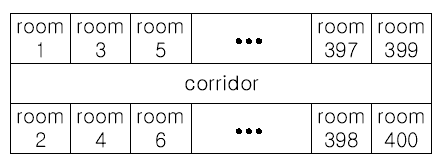HDU 1050 Moving Tables
2015-06-07 23:54
274 查看
Moving Tables
Time Limit: 2000/1000 MS (Java/Others) Memory Limit: 65536/32768 K (Java/Others)Total Submission(s): 23044 Accepted Submission(s): 7749
Problem Description
The famous ACM (Advanced Computer Maker) Company has rented a floor of a building whose shape is in the following figure.

The floor has 200 rooms each on the north side and south side along the corridor. Recently the Company made a plan to reform its system. The reform includes moving a lot of tables between rooms. Because the corridor is narrow and all the tables are big, only
one table can pass through the corridor. Some plan is needed to make the moving efficient. The manager figured out the following plan: Moving a table from a room to another room can be done within 10 minutes. When moving a table from room i to room j, the
part of the corridor between the front of room i and the front of room j is used. So, during each 10 minutes, several moving between two rooms not sharing the same part of the corridor will be done simultaneously. To make it clear the manager illustrated the
possible cases and impossible cases of simultaneous moving.

For each room, at most one table will be either moved in or moved out. Now, the manager seeks out a method to minimize the time to move all the tables. Your job is to write a program to solve the manager’s problem.
Input
The input consists of T test cases. The number of test cases ) (T is given in the first line of the input. Each test case begins with a line containing an integer N , 1<=N<=200 , that represents the number of tables to move. Each of the following N lines contains
two positive integers s and t, representing that a table is to move from room number s to room number t (each room number appears at most once in the N lines). From the N+3-rd line, the remaining test cases are listed in the same manner as above.
Output
The output should contain the minimum time in minutes to complete the moving, one per line.
Sample Input
3 4 10 20 30 40 50 60 70 80 2 1 3 2 200 3 10 100 20 80 30 50
Sample Output
10 20 30
#include <stdio.h>
#include <algorithm>
#include <cstring>
using namespace std;
int main()
{
int T,N;
int c[401];
while (scanf("%d", &T)!=EOF)
{
while (T--)
{
scanf("%d", &N);
int a,b;
int max = -1;
memset(c, 0, sizeof(c));
for(int i=0; i<N; i++)
{
scanf("%d %d", &a, &b);
//将区间限制为从小到大地移动桌子
if (a > b)
{
swap(a, b);
}
//由于走廊两边的排列都是奇数与偶数相对,而任何一个要移动,
//都会影响对面的不能被使用,也就是shared
//所以,如果是偶数开始,那么会影响到对面的,也就是a-1
//同理,如果是奇数结束,也会影响到对面的,也就是b+1
//那么在这个区间都是被shared的
if (a%2 == 0)
a--;
if (b%2 == 1)
b++;
for (int i=a; i<=b; i++)
{
//标记被shared的区间[a, b],被使用一次加一次,所以是c[i]++
c[i]++;
//找重叠数最大之一,即必须经过的次数
if (c[i]>max)
max = c[i];
}
}
printf("%d\n", max*10);
}
}
return 0;
}
相关文章推荐
- iOS开发拓展篇—封装音频文件播放工具类
- iOS开发拓展篇—CoreLocation简单介绍
- hadoop相关资料
- 无法解析此远程名称: 'www.***.com' 解决办法 请求因 HTTP 状态 417 失败
- jsp三层架构
- To_10_r_100_1---N个孩子站成一排,给每个人设定一个权重(已知)。按照如下的规则分配糖果
- Python最简单的图形编程
- linux ubuntu 下面安装google浏览器
- 【转】vc++6.0 字节定义和字节转换。
- 通信阶段的总结
- iOS开发拓展篇—音乐的播放
- iOS开发拓展篇—UIDynamic(简单介绍)
- iOS开发拓展篇—音效的播放
- <style name="Theme.Base.AppCompat.DialogWhenLarge" 的错误是error: Error retrieving parent for item: No
- ASP.NET合并两个相关联的DataTable
- Android事件处理
- maven repository
- netty学习之二:ByteBuf解读
- 关于“服务器提交了协议冲突. Section=ResponseStatusLine"问题
- IIS的真正并发数及扩展并发的办法
